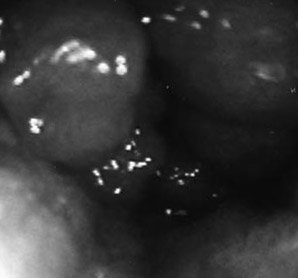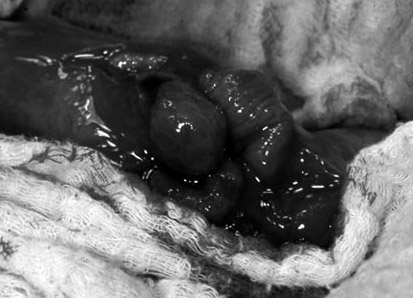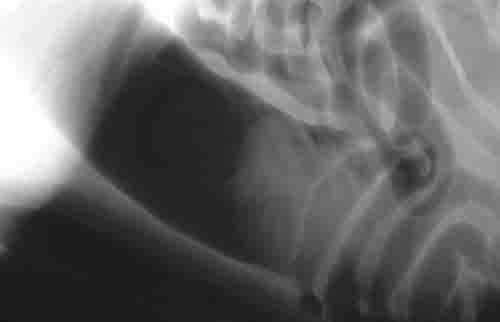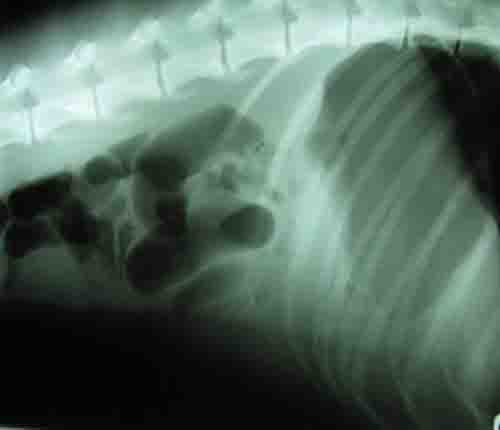Dog stomach blockages (also called gastric outflow obstruction) occur when the stomach has trouble emptying its contents. The pyloric canal is a stomach outlet where inflammation and scarring block the pyloric canal. There are two forms, complete and partial.
In younger dogs, a condition called pyloric stenosis, where there is a narrowing between the stomach and the small intestine is a common cause of any blockage. The condition causes fluids to accumulate in the stomach. When the dog vomits it results in the loss of fluid, causing dehydration and other symptoms. When the small intestine is obstructed vomiting also results.
Symptoms to Look For:
- vomiting
- diarrhea
- abdominal pain
- anorexia
Causes
Conditions that block the digestive system and causes a dog stomach blockage includes ulcers and gastritis. Other causes includes:
- Neoplasia: (rare in dogs). Neoplasia are tumors that grow and obstruct the gastrointestinal system.

Photo Credit: R.M. Bright
- Gastritis:
- Eosinophilic gastritis: white blood cells accumulate among the stomach wall
- Atrophic gastritis: thinning of the stomach walls
- Hypertrophic gastritis: the membranes in the lower half other stomach become thickened can cause blockage and keeps food from exiting the stomach
- Granulomatous gastritis: mass that inflames the stomach lining
- Gastroenteritis: inflammation of the stomach and intestines due to bacterial or viral infection
- Foreign bodies and bezoars also can cause an obstruction, often in younger dogs.
- Chronic hypertrophic gastropathy (CHG)
- Pyloric stenosis: narrowing of the passage where stomach empties into the small intestine (duodenum)
- Acquired Antral Pyloric Gastropathy: affects middle aged and small breeds. The disease causes enlarged (hypertrophic) mucosa (membrane that lines the stomach) and the circular smooth muscle.

The small intestine can be obstructed by:
- One section of intestine enfolding on another (intussusception)

- Hernia
- Twisting (volvulus or torsion)
- Abnormal cell growth (neoplasia)
- Granulomatous enteritis
- Stricture: narrowing of the intestine
- Foreign Body

Breeds Susceptible to Gastric Outflow Obstruction
- Dogs with flat faces (brachycephalic) can get a condition called congenital pyloric stenosis. Affects any brachycephalic breed such as bulldogs, boxers and Boston terriers).
- Acquired chronic hypertrophic gastropathy occurs in Lhasa apsos, Shih tzus, Poodles and Pekingese
- Large breed dogs suffer from gastric dilation and volvulus (bloat)
Symptoms
If the stomach is only partially blocked then one symptom is vomiting more than 12 hours after eating. Vomiting should be differentiated from regurgitation. Vomiting food 8 hours or more after eating is consistent with gastric retention. Regurgitation after eating is not. You might see blood and partially digested food. If completely blocked then your dog will vomit forcibly right after eating.
Other symptoms include:
- Malaise
- Lethargy
- Excessive salivation (ptyalism)
- Weight loss
- Lack of appetite
- Diarrhea
- Dark stools that contain blood (melena)
Diagnosis:
A dog stomach blockage is diagnosed with X-Rays or ultrasound. Other tests include a Gastroscopy or GI series, blood and urine tests. The veterinarian will look for abdominal pain, signs of dehydration, or any abdominal masses.
The veterinarian will look in the mouth for any foreign bodies.
Other possible causes that need to be eliminated before reaching a diagnosis includes:
- Kidney failure
- Infectious gastroenteritis (inflammation of the stomach lining) caused by parasites, bacterial or a virus
- Pancreatitis
- Peritonitis: inflammation of the peritoneum which is caused by a bacterial infection
- Poisoning
- Gastroduodenal ulcer disease
- Gastroenteritis with no known cause
- Central Nervous System Diseases
Treatment:
Surgery is used to correct the dog stomach blockage or obstruction. Sudden intestinal obstructions are treated as an emergency. Intravenous fluids are needed to rehydrate the patient and to provide circulatory support.
After vomiting has ended, a bland diet is provided for 1 to 2 days. After 2 days a patient can resume a normal diet
If surgery is used, patients are monitored for peritonitis (inflammation). Dogs with obstructions caused by foreign objects are often repeat offenders and will need to be monitored.
Prognosis:
The prognosis for an obstruction or dog stomach blockage is good to excellent in uncomplicated cases. The prognosis is initially guarded where there is any perforation of the intestines. Any folding of the peritoneum that attaches the stomach, small intestine, pancreas, spleen and other organs to the posterior wall of the abdomen leads to a poor to grave prognosis.
Have A Question For Our Vet About A Dog Stomach Problem?
Do you have a question for our veterinarian about a dog stomach problem? Share it and we will answer it for free!
Please include your dog's age, breed, medical history and if possible, a picture of the condition.
We will do our best to get back to you quickly (it depends on how many questions we receive each day). If you do require an immediate response we suggest using this online dog veterinary service that is available now.
Brochures:
For More Information
Gastrointestinal Obstruction in Dogs
Author: Merck
Researched by: Jeff Grill
